Shauli Ravfogel
Diversity Over Quantity: A Lesson From Few Shot Relation Classification
Dec 06, 2024Abstract:In few-shot relation classification (FSRC), models must generalize to novel relations with only a few labeled examples. While much of the recent progress in NLP has focused on scaling data size, we argue that diversity in relation types is more crucial for FSRC performance. In this work, we demonstrate that training on a diverse set of relations significantly enhances a model's ability to generalize to unseen relations, even when the overall dataset size remains fixed. We introduce REBEL-FS, a new FSRC benchmark that incorporates an order of magnitude more relation types than existing datasets. Through systematic experiments, we show that increasing the diversity of relation types in the training data leads to consistent gains in performance across various few-shot learning scenarios, including high-negative settings. Our findings challenge the common assumption that more data alone leads to better performance and suggest that targeted data curation focused on diversity can substantially reduce the need for large-scale datasets in FSRC.
Counterfactual Generation from Language Models
Nov 11, 2024Abstract:Understanding and manipulating the causal generation mechanisms in language models is essential for controlling their behavior. Previous work has primarily relied on techniques such as representation surgery -- e.g., model ablations or manipulation of linear subspaces tied to specific concepts -- to intervene on these models. To understand the impact of interventions precisely, it is useful to examine counterfactuals -- e.g., how a given sentence would have appeared had it been generated by the model following a specific intervention. We highlight that counterfactual reasoning is conceptually distinct from interventions, as articulated in Pearl's causal hierarchy. Based on this observation, we propose a framework for generating true string counterfactuals by reformulating language models as Generalized Structural-equation. Models using the Gumbel-max trick. This allows us to model the joint distribution over original strings and their counterfactuals resulting from the same instantiation of the sampling noise. We develop an algorithm based on hindsight Gumbel sampling that allows us to infer the latent noise variables and generate counterfactuals of observed strings. Our experiments demonstrate that the approach produces meaningful counterfactuals while at the same time showing that commonly used intervention techniques have considerable undesired side effects.
GRADE: Quantifying Sample Diversity in Text-to-Image Models
Oct 29, 2024



Abstract:Text-to-image (T2I) models are remarkable at generating realistic images based on textual descriptions. However, textual prompts are inherently underspecified: they do not specify all possible attributes of the required image. This raises two key questions: Do T2I models generate diverse outputs on underspecified prompts? How can we automatically measure diversity? We propose GRADE: Granular Attribute Diversity Evaluation, an automatic method for quantifying sample diversity. GRADE leverages the world knowledge embedded in large language models and visual question-answering systems to identify relevant concept-specific axes of diversity (e.g., ``shape'' and ``color'' for the concept ``cookie''). It then estimates frequency distributions of concepts and their attributes and quantifies diversity using (normalized) entropy. GRADE achieves over 90% human agreement while exhibiting weak correlation to commonly used diversity metrics. We use GRADE to measure the overall diversity of 12 T2I models using 400 concept-attribute pairs, revealing that all models display limited variation. Further, we find that these models often exhibit default behaviors, a phenomenon where the model consistently generates concepts with the same attributes (e.g., 98% of the cookies are round). Finally, we demonstrate that a key reason for low diversity is due to underspecified captions in training data. Our work proposes a modern, semantically-driven approach to measure sample diversity and highlights the stunning homogeneity in outputs by T2I models.
Intrinsic Evaluation of Unlearning Using Parametric Knowledge Traces
Jun 17, 2024



Abstract:The task of "unlearning" certain concepts in large language models (LLMs) has attracted immense attention recently, due to its importance for mitigating undesirable model behaviours, such as the generation of harmful, private, or incorrect information. Current protocols to evaluate unlearning methods largely rely on behavioral tests, without monitoring the presence of unlearned knowledge within the model's parameters. This residual knowledge can be adversarially exploited to recover the erased information post-unlearning. We argue that unlearning should also be evaluated internally, by considering changes in the parametric knowledge traces of the unlearned concepts. To this end, we propose a general methodology for eliciting directions in the parameter space (termed "concept vectors") that encode concrete concepts, and construct ConceptVectors, a benchmark dataset containing hundreds of common concepts and their parametric knowledge traces within two open-source LLMs. Evaluation on ConceptVectors shows that existing unlearning methods minimally impact concept vectors, while directly ablating these vectors demonstrably removes the associated knowledge from the LLMs and significantly reduces their susceptibility to adversarial manipulation. Our results highlight limitations in behavioral-based unlearning evaluations and call for future work to include parametric-based evaluations. To support this, we release our code and benchmark at https://github.com/yihuaihong/ConceptVectors.
On Affine Homotopy between Language Encoders
Jun 04, 2024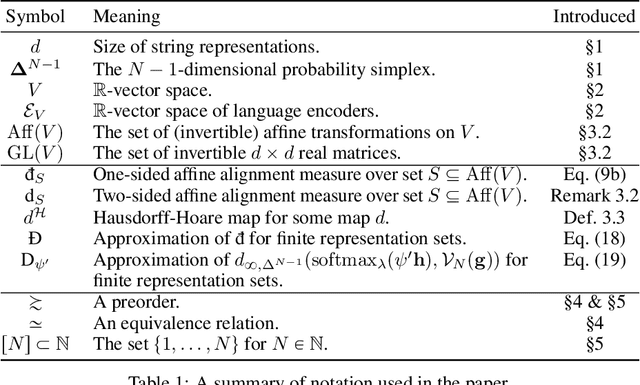
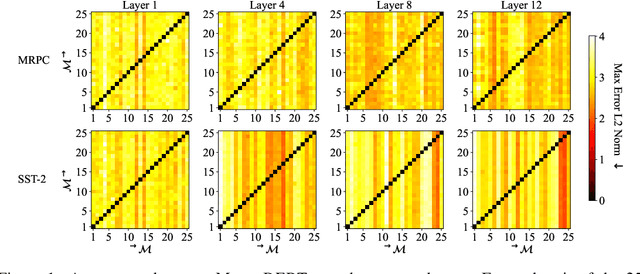
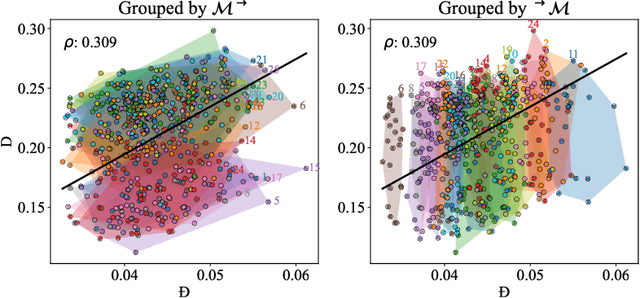
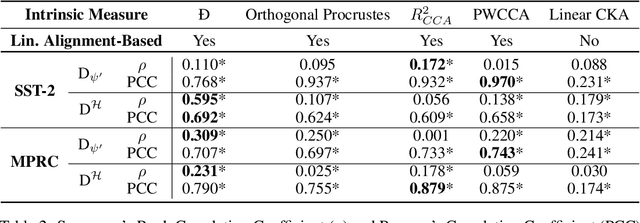
Abstract:Pre-trained language encoders -- functions that represent text as vectors -- are an integral component of many NLP tasks. We tackle a natural question in language encoder analysis: What does it mean for two encoders to be similar? We contend that a faithful measure of similarity needs to be \emph{intrinsic}, that is, task-independent, yet still be informative of \emph{extrinsic} similarity -- the performance on downstream tasks. It is common to consider two encoders similar if they are \emph{homotopic}, i.e., if they can be aligned through some transformation. In this spirit, we study the properties of \emph{affine} alignment of language encoders and its implications on extrinsic similarity. We find that while affine alignment is fundamentally an asymmetric notion of similarity, it is still informative of extrinsic similarity. We confirm this on datasets of natural language representations. Beyond providing useful bounds on extrinsic similarity, affine intrinsic similarity also allows us to begin uncovering the structure of the space of pre-trained encoders by defining an order over them.
Language Imbalance Can Boost Cross-lingual Generalisation
Apr 11, 2024Abstract:Multilinguality is crucial for extending recent advancements in language modelling to diverse linguistic communities. To maintain high performance while representing multiple languages, multilingual models ideally align representations, allowing what is learned in one language to generalise to others. Prior research has emphasised the importance of parallel data and shared vocabulary elements as key factors for such alignment. In this study, we investigate an unintuitive novel driver of cross-lingual generalisation: language imbalance. In controlled experiments on perfectly equivalent cloned languages, we observe that the existence of a predominant language during training boosts the performance of less frequent languages and leads to stronger alignment of model representations across languages. Furthermore, we find that this trend is amplified with scale: with large enough models or long enough training, we observe that bilingual training data with a 90/10 language split yields better performance on both languages than a balanced 50/50 split. Building on these insights, we design training schemes that can improve performance in all cloned languages, even without altering the training data. As we extend our analysis to real languages, we find that infrequent languages still benefit from frequent ones, yet whether language imbalance causes cross-lingual generalisation there is not conclusive.
What Changed? Converting Representational Interventions to Natural Language
Feb 17, 2024Abstract:Interventions targeting the representation space of language models (LMs) have emerged as effective means to influence model behavior. These methods are employed, for example, to eliminate or alter the encoding of demographic information such as gender within the model's representations, creating a counterfactual representation. However, since the intervention operates within the representation space, understanding precisely which features it modifies poses a challenge. We show that representation-space counterfactuals can be converted into natural language counterfactuals. We demonstrate that this approach enables us to analyze the linguistic alterations corresponding to a given representation-space intervention and to interpret the features utilized for encoding a specific concept. Moreover, the resulting counterfactuals can be used to mitigate bias in classification.
MiMiC: Minimally Modified Counterfactuals in the Representation Space
Feb 16, 2024Abstract:Language models often exhibit undesirable behaviors, such as gender bias or toxic language. Interventions in the representation space were shown effective in mitigating such issues by altering the LM behavior. We first show that two prominent intervention techniques, Linear Erasure and Steering Vectors, do not enable a high degree of control and are limited in expressivity. We then propose a novel intervention methodology for generating expressive counterfactuals in the representation space, aiming to make representations of a source class (e.g., "toxic") resemble those of a target class (e.g., "non-toxic"). This approach, generalizing previous linear intervention techniques, utilizes a closed-form solution for the Earth Mover's problem under Gaussian assumptions and provides theoretical guarantees on the representation space's geometric organization. We further build on this technique and derive a nonlinear intervention that enables controlled generation. We demonstrate the effectiveness of the proposed approaches in mitigating bias in multiclass classification and in reducing the generation of toxic language, outperforming strong baselines.
Guiding LLM to Fool Itself: Automatically Manipulating Machine Reading Comprehension Shortcut Triggers
Oct 24, 2023



Abstract:Recent applications of LLMs in Machine Reading Comprehension (MRC) systems have shown impressive results, but the use of shortcuts, mechanisms triggered by features spuriously correlated to the true label, has emerged as a potential threat to their reliability. We analyze the problem from two angles: LLMs as editors, guided to edit text to mislead LLMs; and LLMs as readers, who answer questions based on the edited text. We introduce a framework that guides an editor to add potential shortcuts-triggers to samples. Using GPT4 as the editor, we find it can successfully edit trigger shortcut in samples that fool LLMs. Analysing LLMs as readers, we observe that even capable LLMs can be deceived using shortcut knowledge. Strikingly, we discover that GPT4 can be deceived by its own edits (15% drop in F1). Our findings highlight inherent vulnerabilities of LLMs to shortcut manipulations. We publish ShortcutQA, a curated dataset generated by our framework for future research.
The Curious Case of Hallucinatory Unanswerablity: Finding Truths in the Hidden States of Over-Confident Large Language Models
Oct 18, 2023
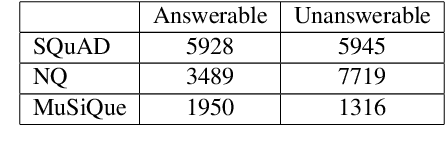

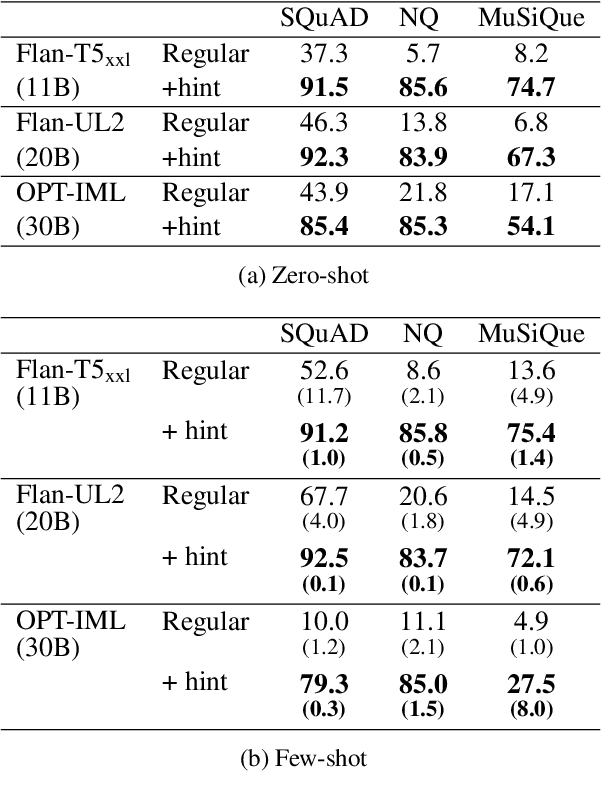
Abstract:Large language models (LLMs) have been shown to possess impressive capabilities, while also raising crucial concerns about the faithfulness of their responses. A primary issue arising in this context is the management of unanswerable queries by LLMs, which often results in hallucinatory behavior, due to overconfidence. In this paper, we explore the behavior of LLMs when presented with unanswerable queries. We ask: do models \textbf{represent} the fact that the question is unanswerable when generating a hallucinatory answer? Our results show strong indications that such models encode the answerability of an input query, with the representation of the first decoded token often being a strong indicator. These findings shed new light on the spatial organization within the latent representations of LLMs, unveiling previously unexplored facets of these models. Moreover, they pave the way for the development of improved decoding techniques with better adherence to factual generation, particularly in scenarios where query unanswerability is a concern.
 Add to Chrome
Add to Chrome Add to Firefox
Add to Firefox Add to Edge
Add to Edge